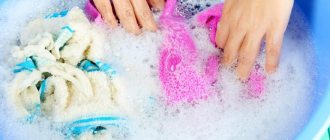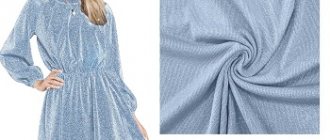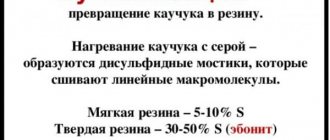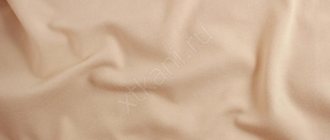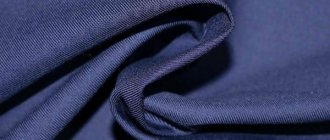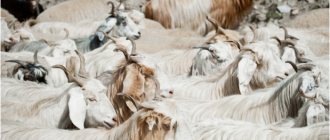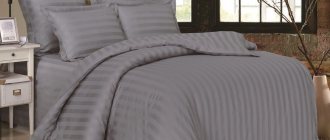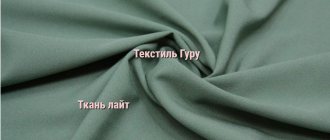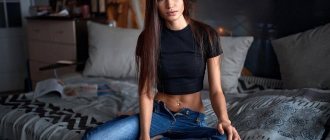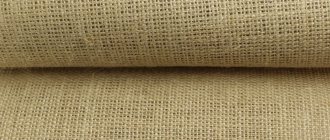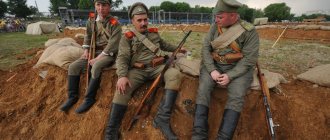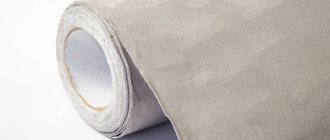It can be argued that recently knitwear has become an increasingly popular type of textile. This is facilitated by both the improvement of technologies for creating raw materials and producing knitted fabrics, as well as their convenience and practicality. Among the varieties of knitwear that have come into use relatively recently, a special place is occupied by footer, which is made from pure cotton or with a small addition of synthetics.
Features of three-thread footer
The principle of producing lining fabric is that two or three threads can be used for it. A dense and strongly twisted warp thread forms a smooth warp fabric. Additional lining threads have a looser structure; they are laid in the form of loops on the wrong side of the warp and create a soft pile . The two-thread material is thin and almost lint-free; in everyday life it is often called knitwear on a bike. A denser and warmer three-thread footer has a warm, soft and fluffy fleece. According to its type, knitted fabric is divided into three categories:
- with a “bike” pile;
- with fleece or knitwear on fleece;
- with fleece "velor".
Regardless of the height of the back pile, three-thread fabric is dense (at least 300 g/sq. meter), warm and elastic. As a rule, such knitwear contains at least 80% cotton, and viscose or polyester is allowed as additives. This material absorbs dyes well, so it is available plain-dyed and printed, as well as in the form of melange (especially gray-white). Products made from it are often decorated with thermal printing, silk-screen printing, and embroidery.
The high demand for three-thread knitwear is due to its high consumer qualities. Due to the high percentage of natural fiber that this material contains, it has the following properties:
- hypoallergenic;
- the property of allowing air and water vapor to pass through even at high pile heights;
- high thermal insulation;
- hygroscopicity;
- strength.
In addition, the structural features of the lining fabric ensure that this material is resistant to deformation and abrasion, and its threads do not stretch or roll down. However, like any cotton fabric, three-thread fabric can shrink and also fade in the sun.
Advantages and disadvantages
Like any other fabric, three-thread footer has its pros and cons. In addition to the fact that things made from footer are soft, warm and comfortable, the material has other advantages.
These include:
- strength, tensile strength, that is, the risk of tearing clothes is minimal;
- long service life, which is not affected by frequent use of clothing and regular washing;
- ability to maintain original shape;
- naturalness and safety, since the content of synthetic fibers in the footer does not exceed 10 percent, therefore 3-thread footer is often used for sewing children's clothing;
- excellent thermal conductivity and air permeability, which allows the skin to breathe;
- hypoallergenic, the material is suitable for people with sensitive skin prone to irritation;
- ease of use and care, the brushed footer can be washed by any means, and the clothes do not develop creases when stored folded.
As for the disadvantages, footer also has them, so when purchasing clothes made from this material it is worth taking them into account.
The disadvantages include low resistance to elevated temperatures and instability to ultraviolet rays.
What do you sew from three threads?
The use of this material depends on its density and pile height.
Bike knitwear is well suited for home wear, especially soft and practical trousers, which have recently become widespread, warm pajamas (especially for children), suits, sweatshirts and other street and sportswear.
Thicker-pile fleece knitwear retains heat well down to sub-zero temperatures and is suitable for sports and travel clothing designed for the cold season, warm linings for jackets and sleeping bags.
Opinions were not divided
The excellent qualities of the footer are proven by positive reviews from owners of items made from this material:
We bought things made of natural footer for the baby for the cold season, the heating in the apartment is not very good, I wanted the child to be both warm and comfortable. Both the rompers and blouses performed very well: they did not cough, did not stretch out, were always soft and did not cause irritation. I am glad that I chose things from this material; the cost is quite affordable for us.
Natalia
I myself love to sew and experiment with fabrics; recently a friend advised me to try footer. I bought thick fabric (2 thread, 100% cotton) and sewed pajamas for my daughter for the off-season. The child liked it, the pajamas are soft, pleasant on the body, after washing they remained bright and retained their shape. I think it’s an excellent material for warm clothes, now I want to buy it for a robe.
Oksana
I like to run in the fresh air, even if it’s cool outside, so I carefully choose tracksuits. They advised me to try one made from footer with lycra, as it is pleasant and warm for the body, and the items will retain their shape even after intensive wear and washing. I bought it, I’ve been wearing it for several years now, I don’t regret my choice at all: the suit is very comfortable, even when I’m sweating, there are no unpleasant sensations, it fits my figure well, and doesn’t hang anywhere.
Evgeniya
Making the right choice
Three-thread products are comfortable and have good warming properties; they are indispensable for sports, other active activities, at home, for walks and out-of-town trips. A sweatshirt made of such knitwear will keep you as warm as a thick woolen sweater, but at the same time it is soft and will not cause irritation to the skin. It is not surprising that warm clothes with fleece are gradually losing their reputation as unpretentious clothing, and are used not only for home or outdoor wear, but also in a work environment. However, in order for them to look decent and last a long time, you need to be able to make the right choice.
The quality of cotton fabric is determined by the length of the cotton fibers.
- The best variety is penya (fiber length is more than 35 mm), the use of which provides a smooth, silky front surface and a stable fluffy back pile.
- Of lower quality are the ring or carde varieties (fibers over 27 mm), which form slight roughness on the surface of the fabric.
- The most inexpensive cotton is open-end, the short fibers of which form lint on the front side and a quickly rolling pile on the back. Therefore, when you see an inexpensive three-thread product on sale, you should not rush to purchase.
- As for three-thread velor, this material is distinguished by not too high, but thick, uniform and very soft pile, reminiscent of the surface of velor. It has a high density, retains heat very well and does not deform even with prolonged use. Velor lining is more expensive, but its quality and elegance are worth the price.
Other ways to reduce the cost of this material are increased synthetic content and low-quality dyes. The most unscrupulous manufacturers even glue the fleece to the smooth fabric, which is discovered after the first wash. Therefore, when purchasing a three-thread thread or a product made from it, be sure to ask the seller for a fabric certificate .
Fabric care
Improper care can render clothes made of even such durable material as 3-thread footer unusable. Therefore, when caring for products made from footer, you need to know about some rules:
- You can wash the footer by hand or in a machine, the main thing is that the water temperature is no higher than 30 degrees;
- to prevent damage to the pile, before washing, clothes made of footer must be turned right side out, all buttons and zippers must be fastened;
- For washing, regular powder is used, if the items are white; for colored clothes, liquid formulations for delicate washing are required;
- if washing is done by hand, then you need to wring out the clothes without force;
- Drying clothes is carried out away from heating radiators and without direct sunlight.
If you follow these simple rules, clothes made from footer will last for many years without losing their original qualities.
Helpful information:
Cooler what kind of fabric?
What kind of fabric is percale?
We wash it correctly
One of the advantages that makes knitted clothing popular is its ease of care. However, in order for a durable and warm three-thread to remain beautiful for as long as possible, certain rules must be followed.
- Even if the material does not contain synthetic fibers, the washing temperature should not exceed 50 degrees.
- To maintain bright colors and finishes, use mild detergents without bleaches.
- Although permanent dyes are used for high-quality fabrics, it is better to dry three-thread items in the shade.
- This material does not need ironing, but if desired, you can use the iron in the “Cotton” mode for high pile and “Synthetic” for thin pile.
Compound
3-thread footer is a natural fabric based on cotton. The composition also contains a small amount of synthetic fibers, which make the product not only elastic, but also durable.
Production consists of two stages. In the first of them, using smooth fibers, the primary fabric is woven. Then loosely twisted threads are added to the fabric using a loop broach. As a result, a three-thread footer is a double-sided material with a pile on the back side and a smooth front side.
Scope of application of the material
The following main areas of application of the material can be distinguished:
- Matting - a rough and hard material is the main raw material for sewing workwear. High strength and wear resistance make it possible to sew protective gloves, suits and overalls for firefighters, builders and welders.
- For needlework. The matting is used for embroidery and crafts.
- In the furniture industry.
- In the printing house for lining and sizing of books.
- Tailoring. This area of application is perhaps the largest. It is the two-thread apperated thread that has received great love among designers and buyers. And high quality and affordable prices for raw materials allow us to sew fashionable casual clothing and tracksuits.
pros
- Softness, hypoallergenic;
- Resistance to deformation (dimensional stability). The higher the density, the stronger this property;
- Wear resistance;
- Thermal insulation;
- Breathability.
It is absolutely natural that, having such characteristics and different densities, footer has found wide application in tailoring. Children's, teenage and adult clothes are made from it, from rompers to jackets. Dresses, sweaters, pants, hoodies, anoraks, sweatshirts, hats, etc., etc.
Thanks to the modern production of footer with the addition of lycra, it is perfect for sports, outdoor activities and extreme tourism.
By adding polyester and lycra, the fabric has better elasticity and service life is much longer. The fabric does not pill, practically no puffs form on it, no lint is used when wearing and washing, maintaining its quality.
The footer cannot be boiled or even washed at temperatures above 40 degrees.
Types and applications
- Single thread. Thin fabric with barely visible lint on the reverse side. Single thread is used to sew clothes for newborns, diapers and comfortable underwear. This fabric is always 100% natural, and the quality of cotton provides such items with a long service life and additional density and strength.
- Double thread. You've probably seen clothes made from double-thread footer more than once, or you already have them in your wardrobe - it's hard to pass by and not buy soft, cozy and warm wardrobe items. Synthetic additives are often used here, but their quantity is not large, which means things do not lose their environmental friendliness characteristic of natural fabrics. Casual clothes are sewn from double-thread fabric - dresses, sweatshirts, sweaters, trousers, skirts. It is good for sports, children's, and home wear - as you can see, the range of applications is quite wide. If you are interested in this material, we suggest you read about what kind of double-thread lining fabric is in a separate article on our website.
- Three-strand. This material is the densest, its bouffant is long and thick. It is in three-thread that wool is most often added, because even outerwear is sewn from it. As well as tracksuits and warm dressing gowns and pajamas.
Quality
Like all knitwear, depending on the raw material, the method of spinning and processing of the resulting material, a footer can have the following quality:
- singing;
- Boxing ring;
- Openend.
Long-staple cotton is used to produce Peigne yarn and is considered the finest yarn. Medium-fiber raw materials are the basis for producing Ring (or Carde) yarn, and short fibers form Openend (they can also be mixed with waste from the first two types).
Openend is very inexpensive and allows you to create the cheapest possible clothes. The most expensive specimens, which are in great demand, are made from peña.
Reviews
People who dealt with this material left reviews and told us what kind of fabric footer foam is.
Natalya, 29 years old: When I found out that I was pregnant, I decided to prepare the baby’s dowry myself. I love to sew, and it’s just nice to make something while waiting joyfully. All my warm rompers, vests, caps and diapers are made from this material. I am sure that my son will be comfortable and cozy in these things
Maria, 43 years old: I have a wonderful sports suit made from this material. Things are already 7 years old and even if I wear clothes neatly, it’s amazing. Constant washing did not affect the shape at all, the pile did not fray - you can wear it for another seven years.
How is footer made?
On an industrial scale, knitwear, of course, is not knitted on knitting needles. There are special machines with needles - hooks. The thread is laid on them with a carriage, the hooks are lowered down, knitting one loop row of stockinette stitch. It's more interesting with a footer.
To obtain a loop structure on the wrong side, an additional thread is placed on the needles of an already knitted row in a certain order. It is usually thicker than the warp thread.
Properties
Luxury fiber material has many excellent properties:
- Hygroscopicity and breathability
- Density, strength, wear resistance
- Resistant to tears and abrasions
- Easy care
- Eco-friendly and hypoallergenic
- These things are cozy, pleasant to the body and touch, and most importantly, very warm.
The material also has a weak point - it is very sensitive to ultraviolet rays and high temperatures.
